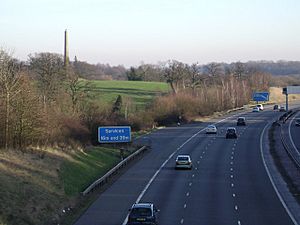Umberslade Obelisk facts for kids
The Umberslade Obelisk is a tall, old stone monument in Warwickshire, England. It's considered an important historical building. A rich landowner named Thomas Archer, 1st Baron Archer, had it built on his land, Umberslade Hall, in 1749. The obelisk is made of grey stone and stands about 21 meters (70 feet) tall. No one knows for sure why it was built. It might have just been to make the view from the hall's windows look nicer. The obelisk is now close to the M40 motorway.
History of the Obelisk
The Umberslade Obelisk was built in 1749 by Thomas Archer, 1st Baron Archer. He owned the large estate of Umberslade Hall nearby. It seems the obelisk was put up when the park around Umberslade Hall was being redesigned. The older, very neat gardens from the 1600s were changed. They became more natural-looking in the mid-1700s. A builder named William Hiorne from Warwick constructed the obelisk.
There are no records that explain why it was built. In 1905, a historian named William Holden Hutton joked that it was "Lord Archer's monument of nothing in particular." Some people think it celebrates when Archer became a lord in 1747.
Others believe it marks the end of the Jacobite rebellion from 1745–1746. This is because Archer was part of the Whig party, who were against the rebellion. There are also local stories. Some say it marks where the last group of witches in Warwickshire met. Another idea is that it's near an old "gospel tree." This was a place where people held informal Christian worship, possibly since the Norman Conquest.
Building obelisks was popular on big English estates back then. So, the monument might simply have been to make the view from Umberslade Hall more beautiful. It was placed so that it could be seen clearly from the hall's windows.
In 1815, a writer named William Field described it. He called it "a fine Obelisk, which forms a striking object from the windows of the house." Soon after it was built, a lady named Henrietta Knight, Lady Luxborough, was even invited to the hall just to see the obelisk from inside. Later, in 1850, travel writer Fanny Parkes noticed that the obelisk "leans fearfully."
What the Obelisk Looks Like
The obelisk is made from smooth, cut grey limestone. It has a square shape. The 21-meter (70-foot) tall obelisk stands on a two-step square base. This base has a decorative edge on its top step. There are no words carved onto the base. At the very top of the obelisk is a stone ball. This ball was once covered in gold. There was also a metal spike on top, which held a copper eight-armed cross (some people thought it looked like a star).
The monument is an important historical structure. It is listed as a Grade II building. This listing notes that it should be seen together with the nearby Obelisk Farmhouse. That farmhouse is also a Grade II listed building. The obelisk was once a main part of the view from the hall. However, its setting has been negatively changed. A group of conifer trees were planted nearby when the M40 motorway was built in the late 1980s.


